Red sand dunes, old-growth mallee woodlands, hot sun, giant ants and a step back in time to an Australia where Malleefowl, Greater Bilbies, Numbats, Bridled Nailtail Wallabies, Mala and bettongs existed without being threatened by habitat destruction and introduced predators – that’s Scotia, blissful Scotia.
The Scotia Wildlife Sanctuary is a woodland nature reserve of 64,659 hectares, 150 kilometres south of Broken Hill, New South Wales, near the South Australia border. It is one of 23 properties owned and expertly managed by the Australian Wildlife Conservancy (AWC). At Scotia, AWC have created the largest fox and cat-free area on the Australian mainland, it is managed by a dedicated team of experts, supported by interns and volunteers, and predominantly funded by tax deductible donations.
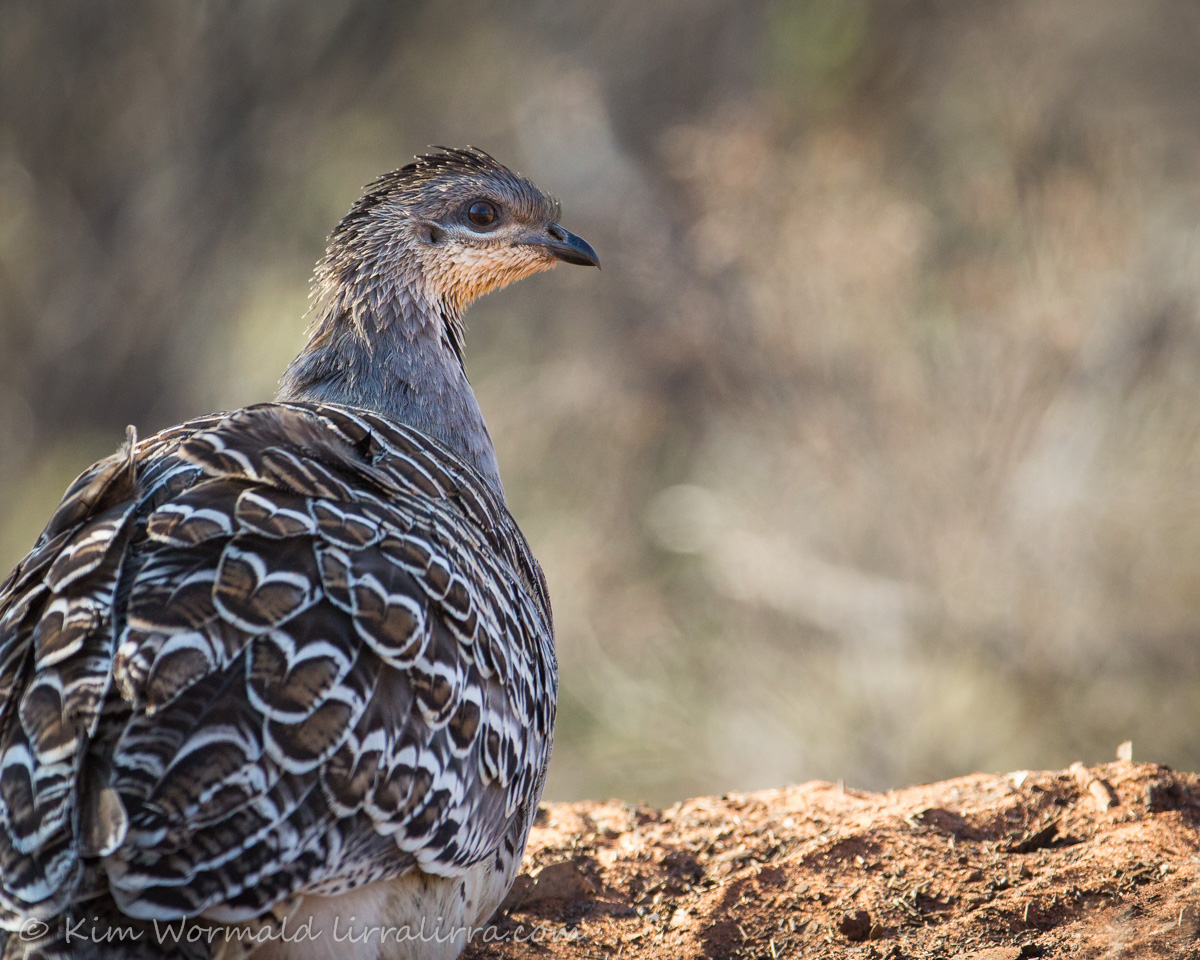 Malleefowl (Leipoa ocellata) – portrait
Malleefowl (Leipoa ocellata) – portrait
‘Photographed with the assistance of Australian Wildlife Conservancy’
I spent many, many hours at a Malleefowl mound and was thrilled every time I caught sight of these magnificent birds.
Malleefowl are one of Australia’s three megapodes, so named because of their large feet; the other two megapodes are the Australian Brush-turkey and the Orange-footed Scrubfowl. All three megapodes incubate their eggs in large mounds. Malleefowl mounds are generally up to about 5 metres in diameter and 1 metre high but mounds of double that size are being used in Western Australia and have been dated to the mega-fauna era.
Graeme and Tim from the National Malleefowl Recovery Team held a mound-monitoring workshop which gave a fascinating overview of Malleefowl behaviour along with instructions on how to check whether a mound is in use without sitting in the ant-ridden bushland for 7 hours a day (which I loved doing despite being impractical). To monitor mounds the height and width are measured and sticks are left crossed on top of the mound to give an indication of whether the mound has been worked since it was last visited. A mound that has been unused for a long period will have moss, lichen and herbs growing on the surface which will have formed a crust following periods of rain. The amount of crust can be checked by lifting a little sand; active mounds have no crust and the sand falls freely when lifted.
Malleefowl (Leipoa ocellata)
‘Photographed with the assistance of Australian Wildlife Conservancy’
Such beautiful feather markings! Male and female birds are alike but it has been suggested that the broad black throat stripe could be distinct enough to identify individual birds. I was impressed by the amount of sand that was moved with each scrape of the massive feet. The Malleefowl worked methodically, taking virtually no notice of me.
Malleefowl (Leipoa ocellata)
‘Photographed with the assistance of Australian Wildlife Conservancy’
The day after the workshop I was at the mound when the female visited to lay an egg, which she does every 4-7 days during the breeding season. The male had excavated the mound, it was an incredible sight that I felt very privileged to see. The lighting was abysmal, the image above was taken at ISO 3200, f/8 and 1/640 second which pushed the boundaries too far for a good image but I’ve included it anyway as I’m still smiling from seeing both birds together. They moved around in the crater of the mound, sometimes disappearing from view, as they softly called to each other.
Malleefowl (Leipoa ocellata)
‘Photographed with the assistance of Australian Wildlife Conservancy’
During autumn a Malleefowl pair begin preparing a previously used mound, generally one they have used before, by excavating it and filling it with leaf litter which becomes wet during the spring rains and starts to rot. The composting process generates heat which the male Malleefowl monitors, using either his feet or his bill (the jury’s still out on that) and regulates to a temperature of 33-34 degrees Celsius by adding or removing sand from the mound. With a temperature range that can include near freezing overnight lows and highs in the mid 40s Celcius it’s remarkable that these birds can maintain the stable temperature required for the eggs to hatch. Once egg-laying begins the female focuses on foraging and it’s believed that she only visits the mound to lay her eggs.
Malleefowl panorama
‘Photographed with the assistance of Australian Wildlife Conservancy’
The panorama image above was created from about a dozen images, the file size is enormous, almost 2GB, which means that at full resolution even the details of the Malleefowl’s eye are well defined.
Malleefowl are capable of moving a vast amount of earth each day. Chicks incubate for about 60 days and then dig their way, unaided, to the surface through up to half a metre of sand. It is an exhausting process which takes 2-15 hours. Chicks are able to run within an hour and fly within a day – what a remarkable species! One morning I saw pieces of damp eggshell and three downy feathers on the mound. I carefully searched the area for a chick, which I didn’t find, though I feel fairly certain one was watching me.
Malleefowl chicks are vulnerable to attack from goannas, snakes and raptors as well as facing starvation if they are unable to find sufficient food; they receive no assistance from the parent birds. Foxes and cats are a major problem for Malleefowl that live away from Scotia. In NSW Malleefowl are listed as endangered, across the country they are vulnerable as their numbers are in such rapid decline.
Malleefowl (Leipoa ocellata)
‘Photographed with the assistance of Australian Wildlife Conservancy’
I’ve included the images, above and below, to give an idea of the stretch involved when the birds are moving earth. The feathers of their underparts look incredibly soft, and the wing patterns are perfect camouflage among the mallee woodlands. At one point I thought I’d seen a Malleefowl only to realise it was a fallen branch complete with twigs and dried leaves.
Malleefowl (Leipoa ocellata)
‘Photographed with the assistance of Australian Wildlife Conservancy’
A feathered backhoe.
Malleefowl (Leipoa ocellata)
‘Photographed with the assistance of Australian Wildlife Conservancy’
The image above shows the bird pausing to ruffle its beautifully patterned feathers.
Malleefowl (Leipoa ocellata)
‘Photographed with the assistance of Australian Wildlife Conservancy’
I am indebted to the AWC for allowing me to spend time at Scotia, I didn’t want to leave. During my time there I spent countless hours with the Malleefowl, I saw Numbats, Greater Bilbies, Bridled Nailtail Wallaby, bettongs and mala along with a large assortment of reptiles and bird species. I met inspiring members of staff, interns, volunteers and researchers. My warmest thanks to the awesome Flic for overseeing my visit and for having such a profound dedication to Scotia. I didn’t want to leave – did I say that already?
Happy birding, Kim
Links:
Scotia Sanctuary
National Malleefowl Recovery Team
~ Thank you for visiting and commenting
~ If you would like a weekly email letting you know that lirralirra has been updated please use the ‘subscribe’ box above right
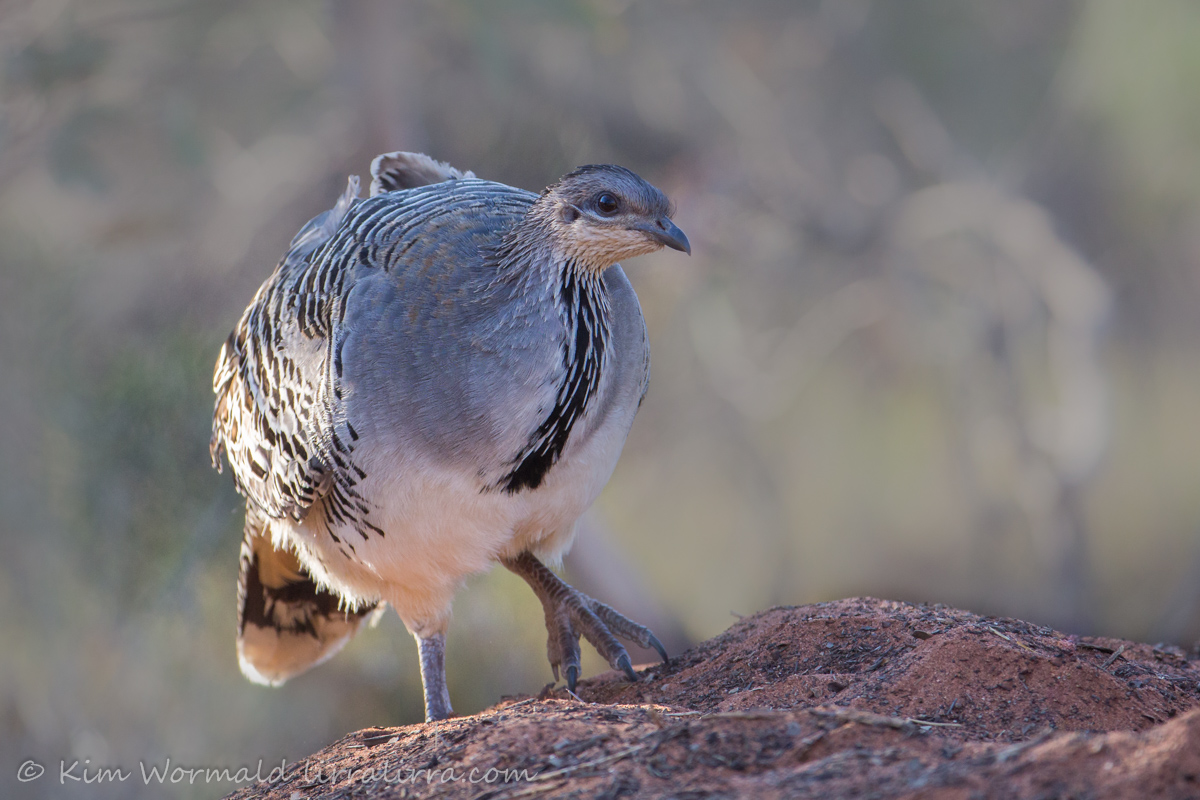
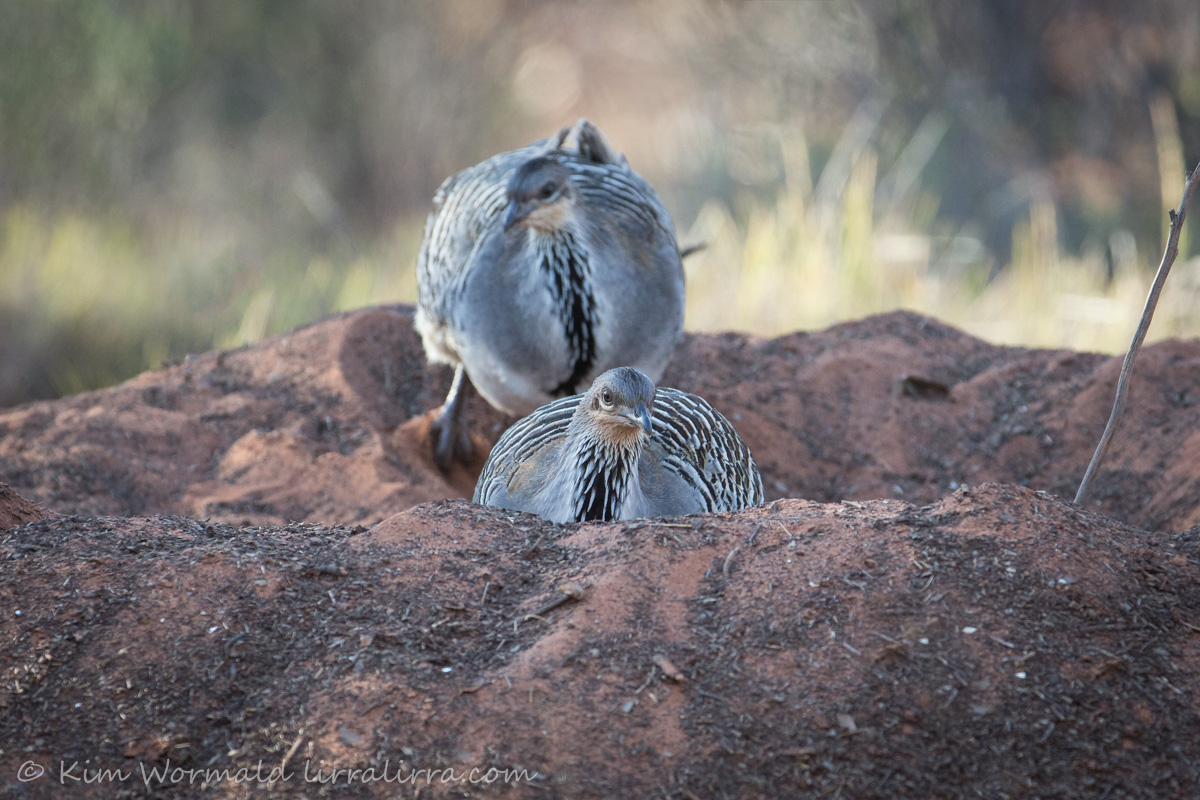
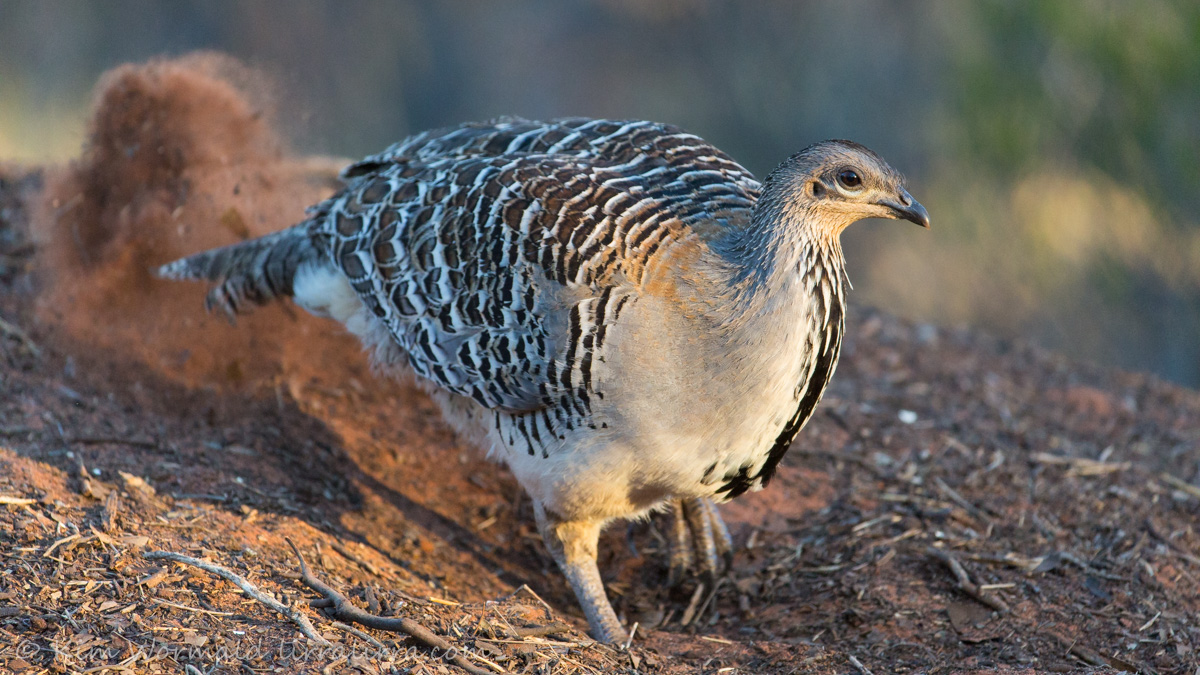
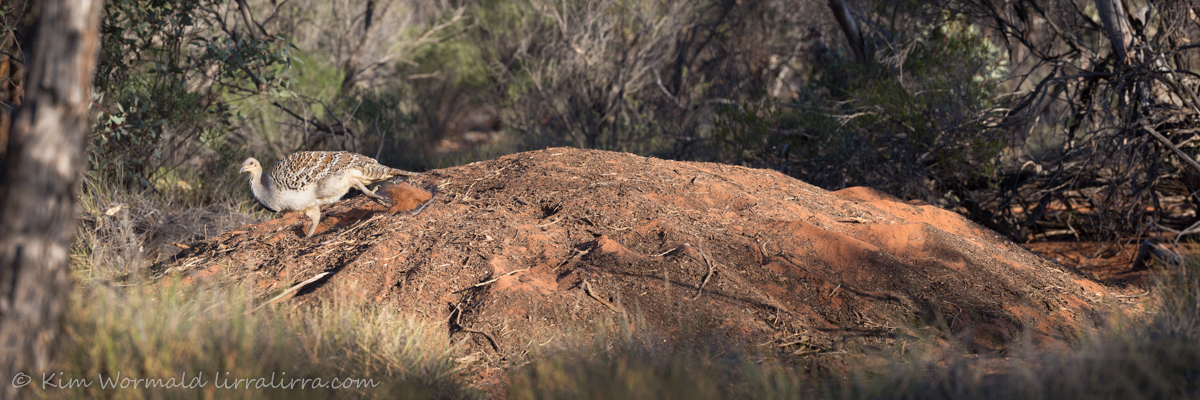


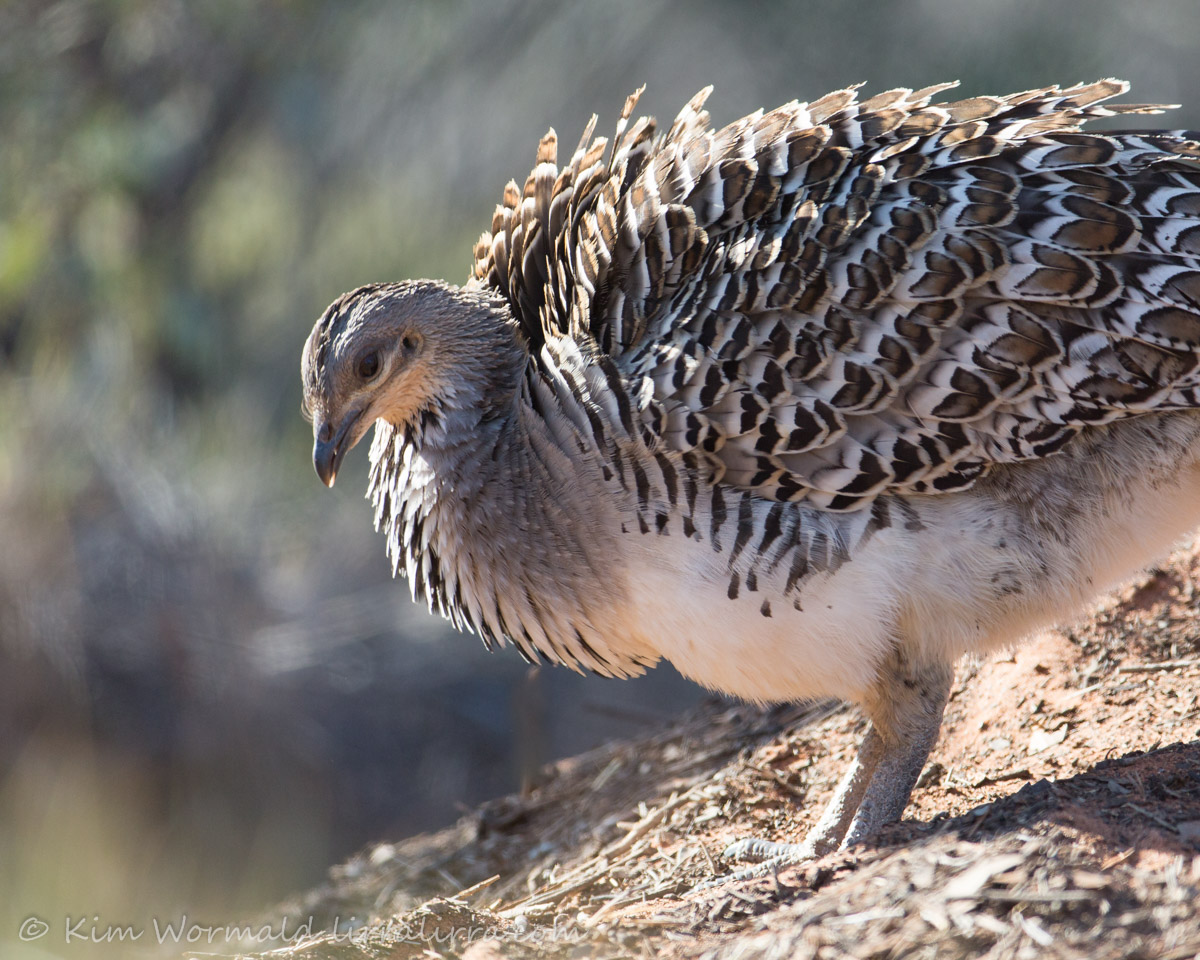
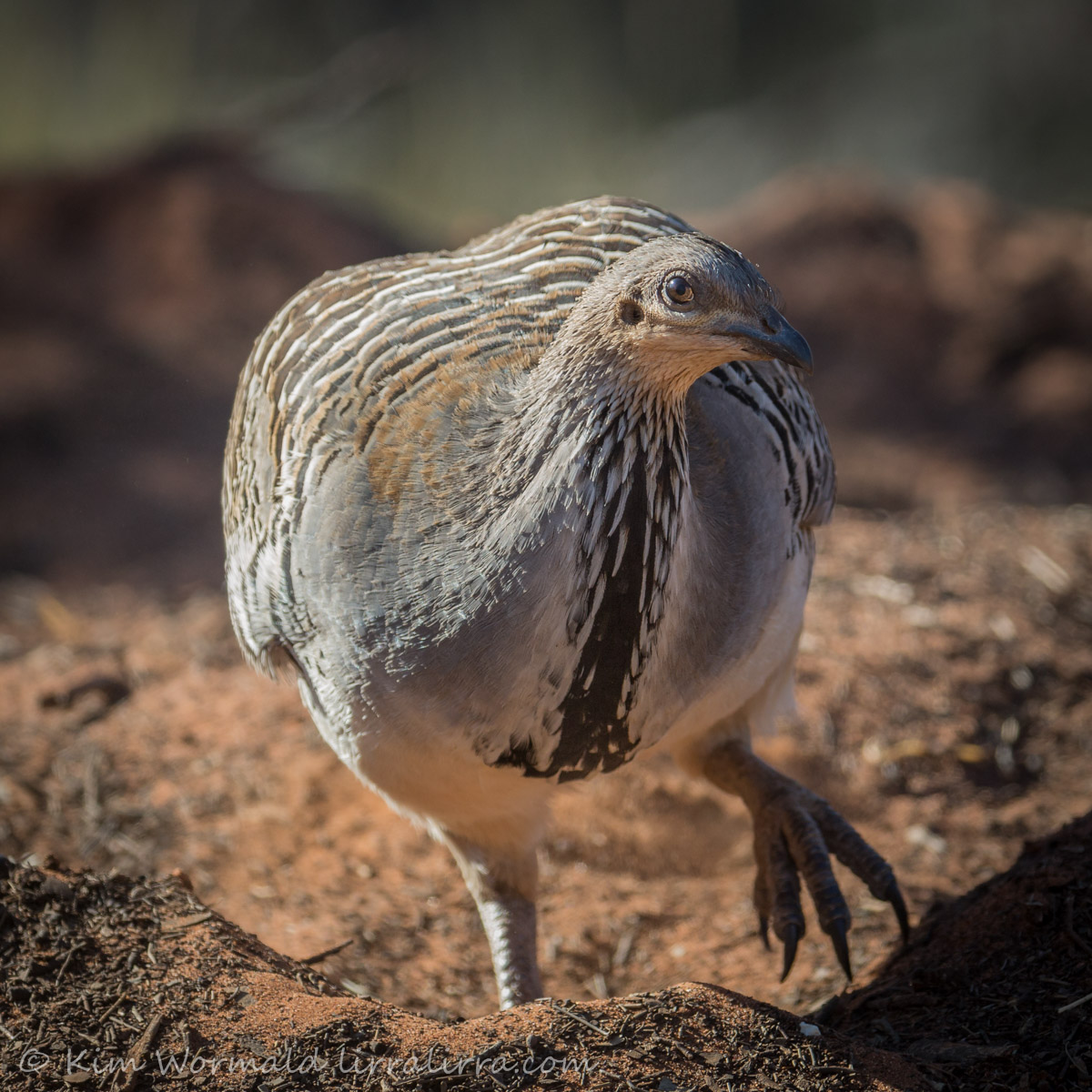

[…] Some sanctuaries, such as the massive Australian Wildlife Conservancy sanctuary at Scotia are more difficult to visit. I had that pleasure a while back, some of my images can be seen by clicking Malleefowl at Scotia […]
These are beautiful images! I have done the monitoring for 6 years now and we only see these birds at times. Its always hot and dusty and uncomfortable but worth it for a glimpse at he birds, as well as knowing our data collection is adding value every year we do it and do doing it as accurately as we can. These images really highlight their wonderful colouring and behaviour. The colours and lighting are terrific. Well done. Thankyou for uploading them.
Hi Judy, thanks for your lovely comments, it’s extra special to know you like the images when you spend so much time monitoring the mounds. Thank you for all you do that is making such a difference to the future of these beautiful birds.
What a fantastic set of images of such a unique bird! It is great to see the photos of them working on their mounds and it is great to see the panorama for perspective on how big they are. The chicks sound quite amazing as does the temperature control! I love the eye on the last picture. It sounds like such a wonderful place up at scotia 😊
They really are remarkable birds Alyssa. I’ve hoped to see them for years so it was especially good to have this opportunity and the Recovery Team’s workshop was excellent. Thanks for letting me know you liked the series 🙂
Followed links from Australian Birds. Thank you for exceptional photos followed with a very informative story. Thanks again
Thank you John. I’m pleased you enjoyed the photographs and information.
PS John, I’ve just tried to visit the website linked with your name but it’s unavailable, could you double check the link as I’d like to visit your site. Thanks, Kim
Oh Kim what an honor for both you and for us! This bird is fascinating and your images are stunning. I am so glad that you take the time to educate us about the birds in your photos and this was so educational. You are AMAZING!
They are incredible birds. I find so much about them fascinating, and how amazing that in some places they are still using mega-fauna Malleefowl mounds. I’m glad you enjoyed hearing about them.
Kim, you can relax from now on, because this is your BEST. True art. And what magnificent subject matter. We simply HAVE to protect–and expand–its habitat. That plumage ‘marked with eyes’ (ocellata) comes out especially strikingly.
I wish I’d added the ‘ocellata’ definition, thank you for highlighting it. And thank you for your lovely comment, you made me smile, lots.
Brilliant photos Kim. Now I want to find a Malleefowl 🙂
I had that feeling for a very long time Marc, and I still have it! I hope you find them soon.
Great photos, Kim…your dedication really shows in these fantastic pictures.
Thank you Carole. I was in my element.
What an absolute privilege for you to see.
Thank you so much for sharing some of the wonder.
And huge thanks to all at the AWC for the incredible work they do.
It’s inspiring that so many people dedicate themselves to improving our environment, without it we’d be in a fine mess. Did you see my comments about Leunig’s sister? I was fascinated by the differences in their work.
I did. She is much darker than I can handle most of the time. Not necessarily wrong, but too dark for me.
I’m fascinated by the similarities in the siblings’ work and by the differences; I think a double biography would be very interesting.